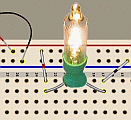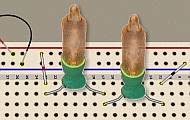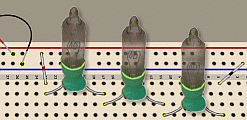Why does adding bulbs make them all dimmer?
We can use a solderless breadboard to connect small light bulbs to a voltage source. A 9-volt battery, for example, makes a bulb burn brightly. When we connect two bulbs in series, however, the pair of bulbs get dim. And if we connect three bulbs, they do not light up at all. See Figures 1, 2, 3.

|

|
|
Figure 1. A circuit with one light bulb. |
|

|

|
|
Figure 2. A circuit with two light bulbs in series. |
|

|

|
| Figure 3. A circuit with three light bulbs in series. | |
What causes a bulb to burn brightly? It's the current! The voltage from the battery is able to move enough electrons through the tiny wire in the bulb's filament to make it white hot. See Figure 1.
When you put two bulbs (two resistors) in series, you've doubled the resistance. See Figure 2. Ohm's Law tells us that will cut the current in half. Less current means less heat in those filaments, and so the lights are not as bright.
When you put three bulbs (three resistors) in series, you've tripled the resistance, and the current is cut even more. See Figure 3. In fact, now there is so little current that the filaments will not glow at all.
What happens if you lift up one of the wires in the series circuit? That opens the circuit. There's no way the electrons can flow. So, there is no current at all! No current means no light. And that's exactly the way a light switch works!
